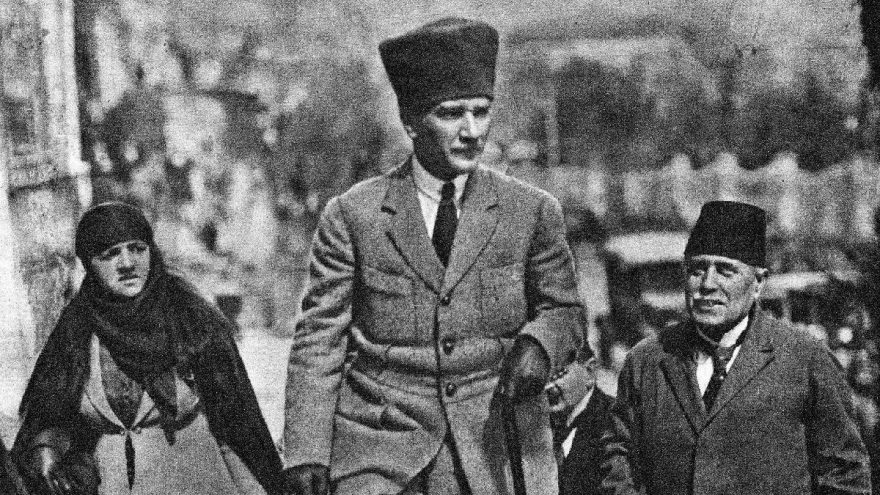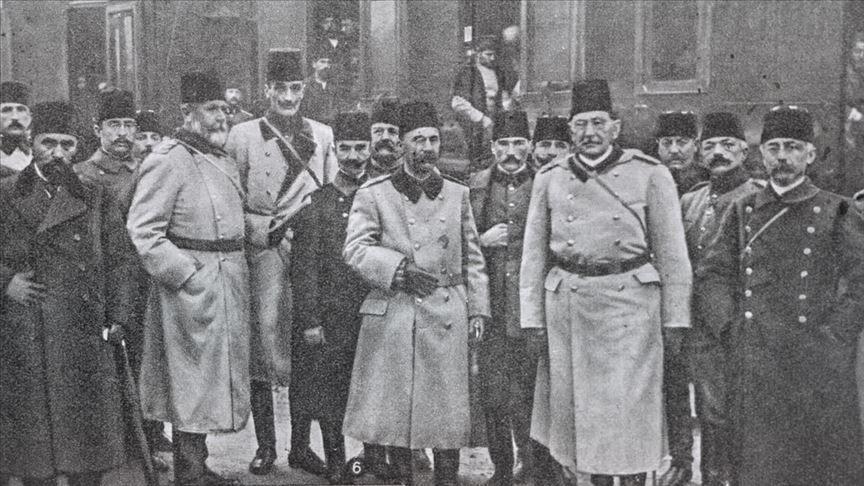Mustafa Kemal Atatürk Chapter 2
Balkan Wars (1912–13)
First Balkan War
The First Balkan War (1912-1913) marked a period during which the Ottoman Empire suffered significant territorial losses in the Balkans. Mustafa Kemal Atatürk played a crucial role in this war, serving as an officer in the Ottoman Army and undertaking various responsibilities on different fronts. Here are some key events and contributions of Atatürk during the First Balkan War:
- Defense of the Çatalca Line: Atatürk was assigned to defend the Çatalca region, a critical defense line for protecting Istanbul. His leadership and strategic abilities in this defensive line garnered attention
- Defense of Edirne: Atatürk was later assigned to defend Edirne after the loss of several significant cities in the Balkans. However, with the fall of Edirne, the course of the war shifted unfavorably for the Ottoman Empire.
- Disarray in the Ottoman Army: The organizational and coordination deficiencies in the Ottoman Army were significant challenges during the First Balkan War. Atatürk observed these issues and began contemplating the consequences of the war.
- Assessment of the Post-War Situation: Atatürk evaluated the dire situation within the Ottoman Empire after the war. The weak administration, army disarray, and territorial losses during this period influenced Atatürk to contemplate initiating a national struggle for independence.
- Reflection on the Post-Balkan Wars Collapse of the Ottoman Empire: The First Balkan War resulted in the Ottoman Empire losing a significant portion of its Balkan territories. This highlighted the empire's weakness and internal issues. Atatürk, during this period, decided to take action for the reconstruction of the country and its quest for independence.
 The First Balkan War played a crucial role in shaping Atatürk's leadership qualities, deepening his sorrow for the collapse of the Ottoman Empire, and inspiring him to lead the Turkish War of Independence in subsequent years.
The First Balkan War played a crucial role in shaping Atatürk's leadership qualities, deepening his sorrow for the collapse of the Ottoman Empire, and inspiring him to lead the Turkish War of Independence in subsequent years.
 (1914–18)
(1914–18)
World War I was a crucial period for the Ottoman Empire, and Mustafa Kemal Atatürk played various roles during this time. Below is a detailed account of Atatürk's role and actions during World War I:
- Gallipoli Campaign (1915): Atatürk assumed command of Ottoman forces in the Gallipoli Campaign. He particularly stood out in the Battle of Conk Bayır, showcasing his leadership skills. However, despite his efforts, Ottoman forces were forced to withdraw from the Gallipoli Peninsula.
- Defense of the Dardanelles (1915-1916): Atatürk played a significant role in the defense of the Dardanelles Strait. The Ottoman Empire successfully repelled attempts by the Allied Powers to breach the Dardanelles. This defense highlighted Atatürk's strategic intelligence and leadership abilities.
- Campaigns in the Arabian Peninsula (1916-1918): During World War I, Atatürk took on various roles in the Arabian Peninsula. He successfully led Ottoman forces, participating in crucial operations like the Siege of Kut al-Amara.
- Battles of Bitlis and Muş (1916): In the Eastern Front, Atatürk commanded Ottoman forces in the battles of Bitlis and Muş against the Russians. However, due to challenging conditions and enemy superiority, these battles were not successful.
- Syrian Front (1918): Towards the end of World War I, Atatürk led Ottoman forces on the Syrian Front. However, with the Ottoman Empire's withdrawal from the war, the Allied Powers occupied Syria.
After World War I, the Ottoman Empire's defeat and the subsequent occupation spurred Atatürk to initiate the national liberation struggle. Landing in Samsun in 1919, he organized the fight for independence in Anatolia, marking the beginning of the Turkish War of Independence. This process ultimately led to the establishment of the modern Republic of Turkey and solidified Atatürk's position as the leader of the Turkish nation.
Ottoman genocides (1913–1924) and Atatürk
Ottoman Massacres:
The genocide carried out by the Ottoman Empire against Armenians during World War I is historically described as a significant tragedy. In 1915, the Ottoman government implemented mass deportations, forced labor, and policies of mass killings targeting the Armenian population. As a result, many Armenians lost their lives due to starvation, harsh conditions, and targeted killings. Internationally, these events are recognized as genocide, forming a major historical monument of remembrance.
Atatürk's Role:
Following the collapse of the Ottoman Empire, Atatürk emerged as a leader who initiated the Turkish War of Independence and established the Republic of Turkey. However, historians hold varying views on whether Atatürk personally participated in or endorsed the Armenian Genocide.
During the establishment of the Republic of Turkey under Atatürk's leadership, there are claims that economic benefits were derived from the lands and properties acquired through the Armenian Genocide. However, there is no consensus among historians regarding Atatürk's individual role in these events. Some historians do not see Atatürk as the architect of the genocide, while others accuse him of being involved in these actions.
In conclusion, the Ottoman Massacres and Atatürk's role in this context remain subjects of controversy among historians. Despite the differing perspectives, these events have left a lasting impact as a significant historical tragedy, acknowledged as genocide by many countries on the international stage.
-Armenian Genocide:
- The Armenian Genocide perpetrated by the Ottoman Empire during World War I between 1915 and 1923 involved mass deportations, forced labor, and systematic killings of the Armenian population. It is widely acknowledged as a genocide by many countries and historians due to the orchestrated nature of the atrocities.
-Atatürk and the Political Landscape After the Genocide:
- Atatürk, as the leader of the Turkish War of Independence following the collapse of the Ottoman Empire, played a pivotal role in the establishment of the Republic of Turkey. However, the extent of Atatürk's direct involvement or the formulation of policies regarding the Armenian Genocide remains a subject of controversy.
 -Distribution of Land and Assets:
-Distribution of Land and Assets:
- During the founding of the Republic of Turkey, economic gains were allegedly derived from the lands and assets acquired through the Armenian Genocide. This has been interpreted as the genocide having economic motives and contributing to the advantage of the new Turkish state.
 -Differing Views on Atatürk's Individual Role:
-Differing Views on Atatürk's Individual Role:
- Historians hold varying opinions regarding Atatürk's direct involvement in the genocide. Some do not consider him as the architect of the genocide and argue against his direct participation. Conversely, others assert that Atatürk was involved in the events, holding him responsible for the atrocities.
 -National and International Reactions:
-National and International Reactions:
- The Armenian Genocide has sparked significant international reactions, with many countries enacting laws recognizing and commemorating the genocide. Turkey, however, maintains a controversial stance, denying the genocide allegations.
- In conclusion, the Armenian Genocide and Atatürk's role in this context remain contentious, with historians expressing diverse perspectives. Nonetheless, there is a general consensus that these events constitute one of the great tragedies in human history.
The Turkish War of Independence and Mustafa Kemal Atatürk: The Rebirth of a Nation
The Turkish War of Independence signifies a crucial period when the Turkish nation initiated a struggle for independence following the occupation and disintegration of the Ottoman Empire after World War I. Led by Mustafa Kemal Atatürk, this epic battle unfolded on the Anatolian lands.
Occupation and Treaty of Sèvres:
After the conclusion of World War I, the Ottoman Empire found itself under occupation as a result of the Armistice of Mudros in 1918. The Allied forces, including British, French, and Italian troops, occupied key regions of the empire. Istanbul, the capital, witnessed foreign occupation, and the Ottoman government became a puppet administration in the hands of the Allies. The Treaty of Sèvres, signed on August 10, 1920, formalized the disintegration of the Ottoman Empire. According to the terms of the treaty, large portions of Ottoman territories were to be ceded to various Allied powers. Greece, in particular, was granted extensive territorial gains, including control over Istanbul and the western Anatolian region.
The Treaty of Sèvres, signed on August 10, 1920, formalized the disintegration of the Ottoman Empire. According to the terms of the treaty, large portions of Ottoman territories were to be ceded to various Allied powers. Greece, in particular, was granted extensive territorial gains, including control over Istanbul and the western Anatolian region.
This occupation and dismemberment of the Ottoman Empire led to profound unrest and discontent among the Turkish population. Mustafa Kemal Atatürk, a military commander who had gained prominence during World War I, recognized the urgency of reclaiming Turkish sovereignty and preventing the disintegration of Turkish lands.
Atatürk's Landing in Samsun: Igniting the Flame of Independence
Mustafa Kemal Atatürk's landing in Samsun on May 19, 1919, stands as a pivotal moment in the history of modern Turkey, marking the commencement of the Turkish War of Independence. Here is a more detailed exploration of this significant event: Background and Context:
Background and Context:
As World War I came to an end in 1918, the Ottoman Empire, allied with the Central Powers, found itself on the losing side. The Armistice of Mudros in October 1918 signaled the beginning of foreign occupation in various parts of the Ottoman territory by Allied forces, primarily British, French, and Italian. Istanbul, the capital of the Ottoman Empire, became occupied, and the Ottoman government, under the leadership of the Ottoman Sultan, Mehmed VI, was rendered powerless.
The post-war settlement negotiations culminated in the Treaty of Sèvres in 1920, a treaty that aimed to dismember the Ottoman Empire and distribute its territories among the victorious Allies. This dire situation fueled discontent among the Turkish population, who saw their homeland being carved up by foreign powers. Atatürk's Mission:
Atatürk's Mission:
Mustafa Kemal Atatürk, a distinguished military commander and a prominent figure during World War I, recognized the urgency of the situation. Concerned about the disintegration of Turkish lands and inspired by the principles of national sovereignty, he embarked on a mission to unite the Turkish people against foreign occupation and to resist the terms of the Treaty of Sèvres. Arrival in Samsun:
Arrival in Samsun:
On May 19, 1919, Atatürk arrived in the Black Sea port city of Samsun. Choosing Samsun strategically, he intended to rally support from both the public and the military in the region. Atatürk was not alone; he was accompanied by a small group of loyal officers who shared his vision of national independence.
Shortly after his arrival in Samsun, Atatürk issued the Amasya Circular on June 22, 1919. This document declared the intentions of the national movement, emphasizing the preservation of the integrity of the homeland and the establishment of a new form of governance based on the will of the people.
Atatürk's landing in Samsun and the subsequent issuance of the Amasya Circular laid the groundwork for the formation of the Turkish national movement. This movement would evolve into the Turkish War of Independence, with Atatürk at its helm.
Atatürk's landing in Samsun was a deliberate and courageous act that ignited the flame of resistance against foreign occupation and laid the foundation for a monumental struggle for national independence. This event marked the beginning of a journey that would ultimately lead to the establishment of the Republic of Turkey and the emergence of Atatürk as its founding father.
- My other articles:
- https://www.bulbapp.io/p/ad64d419-d26e-4b4d-932e-4fce4fd9a8b3/atatrks-early-career
- https://www.bulbapp.io/p/db08e8b6-670c-4983-8f75-833790eab035/title-real-madrid-reflecting-history-with-the-1902-logo
- https://www.bulbapp.io/p/9ecef022-e016-4972-9829-9ba8b22c55a7/eastern-anatolia-aegean-and-marmara-regions-of-turkey
- https://www.bulbapp.io/p/fa3fb0c6-20bc-4d09-87f4-91888971ad60/delicious-iskender-kebab
- https://www.bulbapp.io/p/0a586a32-db5b-4cfb-a467-1cca41f7afe2/eski-ve-yeni-yu-gi-oh-kart-oyunlar-deien-dinamikler-ve-stratejiler
- https://www.bulbapp.io/p/a03d9adb-e6c5-4f1b-9cc0-2b40fffc517b/embracing-financial-change-navigating-the-shifting-landscape






































